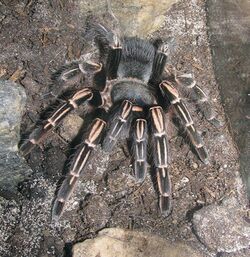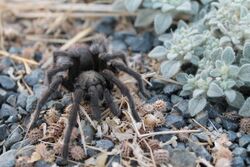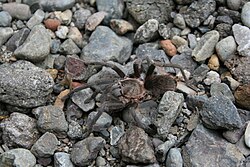Biology:Aphonopelma
| Aphonopelma | |
|---|---|

| |
| Female Aphonopelma seemanni | |
| Scientific classification Error creating thumbnail: Unable to save thumbnail to destination
| |
| Domain: | Eukaryota |
| Kingdom: | Animalia |
| Phylum: | Arthropoda |
| Subphylum: | Chelicerata |
| Class: | Arachnida |
| Order: | Araneae |
| Infraorder: | Mygalomorphae |
| Family: | Theraphosidae |
| Genus: | Aphonopelma Pocock, 1901[1] |
| Type species | |
| Eurypelma seemanni F. O. P.-Cambridge, 1897
| |
| Species | |
|
See text. | |
| Diversity | |
| 54 | |
| Synonyms | |
| |
Aphonopelma is a genus of tarantulas native to the Americas. It includes nearly all the North American tarantula species north of Mexico and a considerable percentage of the tarantula species that range into Central America. Most are fairly large tarantulas with leg spans of 6 in (16 cm) or more. Like most New World tarantulas, all species of Aphonopelma have urticating hairs. Despite their fearsome appearance, these tarantulas are not harmful to humans and some species are popular in the pet trade. With about 90 species described so far, Aphonopelma comprises about 10% of the total number of described tarantula species. However, their taxonomy is poorly understood and species are difficult to tell apart, especially those that are brown or black without other pattern. Therefore, the actual number of species is unknown, with more species likely to be identified in the near future. In captivity, they are usually fed crickets; in the wild, they eat most insects, including crickets, grasshoppers, cockroaches, mantises, and beetles.
Taxonomy
The genus has a complicated taxonomic history. It was erected in 1901 by Reginald I. Pocock, when he split up Eurypelma (now Avicularia), with the type species Eurypelma seemanni. Pocock also separated off the genus Dugesiella. Two more new genera were later distinguished from Aphonopelma: Delopelma by Alexander Petrunkevitch in 1939 and Chaunopelma by Joseph C. Chamberlin in 1940. In 1985, Robert J. Raven reviewed mygalomorph genera and considered the differences among all these genera to be insignificant. He synonymized them under the name Rhechostica, which had been published by Eugène Simon in 1892, so had priority. Since the name Aphonopelma was much better known than Rechostica, the International Commission on Zoological Nomenclature in 1991 agreed to give Aphonopelma precedence over Rhechostica. In 1995, Smith erected the genus Apachepelma for the species A. paloma; in 1997, Prentice transferred it back to Aphonopelma.[2]
Phylogeny
Molecular phylogenetic studies suggest that the genus is not monophyletic. Two groups of species are apparent: one from Central America, including the type species A. seemanni from Costa Rica, and another made up of species found in the United States. The relationship between the two groups and the genus Sericopelma is shown in the cladogram below. With further research, a new genus may be needed for the American group of species.[2]
| |||||||||||||
Species
(As of January 2023), the World Spider Catalog accepted 54 species.[1] A monograph of the genus within the United States, published in 2016, made some major revisions. Only 15 of the original 55 U.S. species were fully accepted, 33 were reduced to synonyms, and seven to nomina dubia (doubtful names). A further 14 new U.S. species were then described.[2]
- Aphonopelma anax (Chamberlin, 1940) – United States , Mexico
- Aphonopelma armada (Chamberlin, 1940) – United States
- Aphonopelma atomicum Hamilton, 2016 – United States
- Aphonopelma bacadehuachi Hendrixson, 2019 – Mexico
- Aphonopelma belindae Gabriel, 2011 – Panama
- Aphonopelma bicoloratum Struchen, Brändle & Schmidt, 1996 – Mexico
- Aphonopelma burica Valerio, 1980 – Costa Rica
- Aphonopelma caniceps (Simon, 1891) – Mexico
- Aphonopelma catalina Hamilton, Hendrixson & Bond, 2016 – United States
- Aphonopelma chalcodes Chamberlin, 1940 – United States
- Aphonopelma chiricahua Hamilton, Hendrixson & Bond, 2016 – United States
- Aphonopelma cookei Smith, 1995 – Mexico
- Aphonopelma crinirufum (Valerio, 1980) – Costa Rica
- Aphonopelma eustathes (Chamberlin, 1940) – Mexico
- Aphonopelma eutylenum Chamberlin, 1940 – United States
- Aphonopelma gabeli Smith, 1995 – United States
- Aphonopelma geotoma (Chamberlin, 1937) – Mexico
- Aphonopelma gertschi Smith, 1995 – Mexico
- Aphonopelma griseum Chamberlin, 1940 – Mexico
- Aphonopelma hageni (Strand, 1906) – Mexico
- Aphonopelma helluo (Simon, 1891) – Mexico
- Aphonopelma hentzi (Girard, 1852) – United States
- Aphonopelma hesperum (Chamberlin, 1917) – Mexico
- Aphonopelma icenoglei Hamilton, Hendrixson & Bond, 2016 – United States
- Aphonopelma iodius (Chamberlin & Ivie, 1939) – United States
- Aphonopelma johnnycashi Hamilton, 2016 – United States
- Aphonopelma joshua Prentice, 1997 – United States
- Aphonopelma levii Smith, 1995 – Mexico
- Aphonopelma madera Hamilton, Hendrixson & Bond, 2016 – United States
- Aphonopelma mareki Hamilton, Hendrixson & Bond, 2016 – United States
- Aphonopelma marxi (Simon, 1891) – United States
- Aphonopelma moderatum (Chamberlin & Ivie, 1939) – United States
- Aphonopelma moellendorfi Hamilton, 2016 – United States
- Aphonopelma mojave Prentice, 1997 – United States
- Aphonopelma mooreae Smith, 1995 – Mexico
- Aphonopelma nayaritum Chamberlin, 1940 – Mexico
- Aphonopelma pallidum (F. O. Pickard-Cambridge, 1897) – Mexico
- Aphonopelma paloma Prentice, 1993 – United States
- Aphonopelma parvum Hamilton, Hendrixson & Bond, 2016 – United States
- Aphonopelma peloncillo Hamilton, Hendrixson & Bond, 2016 – United States
- Aphonopelma phasmus Chamberlin, 1940 – United States
- Aphonopelma platnicki Smith, 1995 – Mexico
- Aphonopelma prenticei Hamilton, Hendrixson & Bond, 2016 – United States
- Aphonopelma prosoicum Chamberlin, 1940 – Mexico
- Aphonopelma ruedanum Chamberlin, 1940 – Mexico
- Aphonopelma saguaro Hamilton, 2016 – United States
- Aphonopelma sclerothrix (Valerio, 1980) – Costa Rica
- Aphonopelma seemanni (F. O. Pickard-Cambridge, 1897) (type species) – Central America
- Aphonopelma steindachneri (Ausserer, 1875) – United States
- Aphonopelma superstitionense Hamilton, Hendrixson & Bond, 2016 – United States
- Aphonopelma truncatum (F. O. Pickard-Cambridge, 1897) – Mexico
- Aphonopelma vorhiesi (Chamberlin & Ivie, 1939) – United States
- Aphonopelma xanthochromum (Valerio, 1980) – Costa Rica
- Aphonopelma xwalxwal Hamilton, 2016 – United States
- Aphonopelma anitahoffmannae Locht, Medina, Rojo & Vázquez, 2005
- Aphonopelma latens (Chamberlin, 1917)
- Aphonopelma crinitum (Pocock, 1901)
- Aphonopelma duplex (Chamberlin, 1925)
In synonymy
Nomina dubia
- Aphonopelma anitahoffmannae Locht, Medina, Rojo & Vázquez, 2005
- Aphonopelma duplex (Chamberlin, 1925)
- Aphonopelma serratum (Simon, 1891)
Species transferred to other genera
Species names rejected in the 2016 monograph include
- Aphonopelma apacheum Chamberlin, 1940 = A. chalcodes
- Aphonopelma arnoldi Smith, 1995 = A. armada
- Aphonopelma baergi Chamberlin, 1940, nom. dub.
- Aphonopelma behlei Chamberlin, 1940 = A. marxi
- Aphonopelma breenei Smith, 1995 = A. anax
- Aphonopelma brunnius Chamberlin, 1940 = A. iodius
- Aphonopelma chambersi Smith, 1995 = A. eutylenum
- Aphonopelma chamberlini Smith, 1995 = A. iodius
- Aphonopelma clarki Smith, 1995 = A. hentzi
- Aphonopelma clarum Chamberlin, 1940 = A. eutylenum
- Aphonopelma coloradanum (Chamberlin, 1940) = A. hentzi
- Aphonopelma cratium Chamberlin, 1940, nom. dub.
- Aphonopelma cryptethum Chamberlin, 1940 = A. eutylenum
- Aphonopelma echinum (Chamberlin, 1940) = A. hentzi
- Aphonopelma gurleyi Smith, 1995 = A. hentzi
- Aphonopelma harlingenum (Chamberlin, 1940) = A. hentzi
- Aphonopelma heterops Chamberlin, 1940 = A. moderatum
- Aphonopelma iviei Smith, 1995 = A. iodius
- Aphonopelma jungi Smith, 1995 = A. vorhiesi
- Aphonopelma lithodomum Chamberlin, 1940 = A. iodius
- Aphonopelma minchi Smith, 1995 = A. chalcodes
- Aphonopelma mordax (Ausserer, 1871), nom. dub.
- Aphonopelma odelli Smith, 1995 = A. hentzi
- Aphonopelma phanum Chamberlin, 1940 = A. steindachneri
- Aphonopelma punzoi Smith, 1995 = A. vorhiesi
- Aphonopelma radinum (Chamberlin & Ivie, 1939), nom. dub.
- Aphonopelma reversum Chamberlin, 1940 = A. steindachneri
- Aphonopelma rothi Smith, 1995 = A. chalcodes
- Aphonopelma rusticum (Simon, 1891), nom. dub.
- Aphonopelma sandersoni Smith, 1995 = A. eutylenum
- Aphonopelma schmidti Smith, 1995 = A. chalcodes
- Aphonopelma smithi Smith, 1995 = A. iodius
- Aphonopelma stahnkei Smith, 1995 = A. chalcodes
- Aphonopelma texense (Simon, 1891), nom. dub.
- Aphonopelma vogelae Smith, 1995 = A. marxi
- Aphonopelma waconum (Chamberlin, 1940) = A. hentzi
- Aphonopelma wichitanum (Chamberlin, 1940) = A. hentzi
- Aphonopelma zionis Chamberlin, 1940 = A. iodius
References
- ↑ 1.0 1.1 "Aphonopelma Pocock, 1901", World Spider Catalog (Natural History Museum Bern), http://www.wsc.nmbe.ch/genus/3323, retrieved 2020-03-01
- ↑ 2.0 2.1 2.2 2.3 Hamilton, Chris A.; Hendrixson, Brent E.; Bond, Jason E. (2016-02-04), "Taxonomic revision of the tarantula genus Aphonopelma Pocock, 1901 (Araneae, Mygalomorphae, Theraphosidae) within the United States", ZooKeys (560): 1–340, doi:10.3897/zookeys.560.6264, PMID 27006611
External links
Wikidata ☰ Q137594 entry
 |




